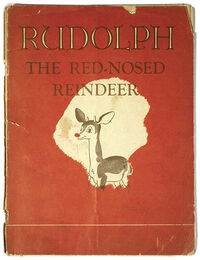
First edition of Rudolph the Red-Nosed Reindeer from 1939.
Rudolph the Red-Nosed Reindeer is a short children's picture book in verse by the American author Robert L. May. It was first published in 1939. The book was commissioned by the Montgomery Ward department store in Chicago and was originally given away free to the store's customers.
The story's title character and protagonist is taunted by other reindeer because of his red nose which glows in the dark. However, it is thanks to Rudolph's glowing nose that Santa Claus is able to deliver presents on a dark Christmas Eve night on which there are no moon or stars. At the end of the story, Rudolph gains the acceptance and admiration of the other reindeer.
In creating the story, Robert L. May was inspired by Hans Christian Andersen's "The Ugly Duckling". Another obvious influence is the poem "A Visit from St. Nicholas". the verse structure of which is imitated in the tale. The book opens with the lines:
- "'Twas the day before Christmas, and all through the hills,
- The reindeer were playing, enjoying their spills",
Robert L. May took over the copyright of Rudolph the Red-Nosed Reindeer in 1947. Commercial printings of the book followed, as did licensed adaptations to other media, the best known of which being the 1949 song by Johnny Marks. Although neither May's book nor Marks' song are in the public domain, Rudolph has come to be considered as a traditional figure of Christmas folklore.
Plot[]
Rudolph is a young reindeer who, unlike others of his kind, has a large red nose that sparkles in the daytime and glows after dark. He is shunned and taunted by other reindeer who do not allow him to play with them. However, Rudolph is always well behaved. As he goes to bed on the night of Christmas Eve, he is certain that Santa Claus will bring him lots of presents.
At the North Pole, Santa Claus is worried because the evening is very foggy. The thick fog prevents him from seeing the moon and stars, which he usually uses to steer his sleigh. He has no choice but to fly low and use the lights from houses to guide him, often getting tangled in treetops as a result. Midnight approaches, parents go to bed also, lights go out in houses and Santa finds himself in almost complete darkness. He has great difficulty seeing where he is going when he goes inside houses.

A mocked-up image of Rudolph the Red-Nosed Reindeer.
Santa eventually arrives at Rudolph's house. He finds that he has no difficulty seeing inside Rudolph's bedroom because of the light from his glowing nose, although it is just as dark in the rest of the house as everywhere else. Santa wakes up Rudolph, tells him of the difficulties he has been having because of the fog and asks him to lead the sleigh for the rest of the night. Rudolph writes a short note to his parents and leaves. For the remainder of the evening, Santa has no trouble seeing where he is going or seeing inside children's bedrooms.
As morning comes, Santa Claus finishes delivering presents and takes Rudolph back to his hometown. Having found out about Rudolph's note to his parents, the other reindeer all know what Rudolph has done, are eager to greet him on his return and feel sorry for having teased him. Santa praises Rudolph's bravery in front of the gathered crowd of reindeer, who call for him to make a speech. However, being very tired, the only thing that Rudolph is able to say before going to sleep is, "Merry Christmas to all, and to all a good night!"
On foggy evenings, Rudolph continues to guide Santa's sleigh and shines the light from his nose into children's bedrooms.
Adaptations[]

Screenshot from the 1964 animated TV special Rudolph the Red-Nosed Reindeer.
An animated cartoon short version of Rudolph the Red-Nosed Reindeer, directed by Max Fleischer, was released in 1948. The cartoon follows the plot of Robert L. May's book very closely, most of the text from the story being spoken by a narrator. The film was re-edited for later releases, with the song "Rudolph the Red-Nosed" being added to the opening credits.
The song "Rudolph the Red-Nosed Reindeer" was written by Johnny Marks, Robert L. May's brother-in-law. It was first recorded by Gene Autry in 1949. The song gives only a very brief outline of May's story.
The Rankin/Bass stop-motion animation TV special Rudolph the Red-Nosed Reindeer was first shown on television in the United States on NBC on December 6, 1964. The special is based on Johnny Marks' song, rather than on Robert L. May's book. The TV special is now more familiar to many people than the book. Consequently, many people are surprised when they read May's book for the first time to discover that, in the original story, Rudolph is not the child of any of Santa Claus' reindeer and there is no reference in the book to him causing shame or embarrassment to his parents.
See also[]
- "Old Santeclaus with Much Delight" (1821)
- "A Letter from Santa Claus" (1875)
- "Goody Santa Claus on a Sleigh Ride" (1889)
- The Goblins' Christmas (1900)
- The Life and Adventures of Santa Claus (1902)
- "A Kidnapped Santa Claus" (1904)
- Father Christmas (1973)
- Father Christmas Goes on Holiday (1975)
- The Polar Express (1985)
- Winnie and Wilbur Meet Santa (2015)
- Santa's Husband (2017)
